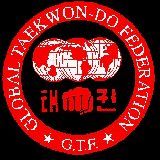|
FALMOUTH COLLEGE OF ART TAEKWON-DO |
||
|
Toi-Gye: is
the penname of the noted scholar Yi Hwang (16th century A.D.), an authority
on Neo-Confucianism. The 37 movements of this pattern refer to his birthplace
on the 37th degree latitude, and the diagram represents "scholar".
[37 moves] Hwa-Rang: is named after the Hwa-Rang youth group which originated
in the Silla Dynasty about 1350 years ago. This group eventually became the
actual driving force for the unification of the three Kingdoms of Korea. The
29 movements refer to the 29th Infantry Division where TaeKwon-Do developed
into maturity. [29 moves] Jee-Goo: means
"Global". The "X" crosses out the years of political
strife in TaeKwon-Do that has been evident worldwide. The first movement
symbolizes the beginning of the new Global TaeKwon-Do Movement - a concept of
global peace and harmony. The 30 movements of the pattern are comprised of
three numbers (24, 4, 2) which explain the purpose. There are 24 hours in
each day; therefore this concept will be with us every second. The four
directions of movements represent the north, south, east and west
encompassing all nations and all people. The four directions are done two
times to reinforce our commitment to bring global peace and harmony to the
world. [30 moves] Choong-Moo: was
the name given to the great Admiral Yi Sun-Sin of the Yi Dynasty. He was
reputed to have invented the first armoured battleship (kobukson) which was
the precursor of the present day submarine in 1592 A.D. The reason why this
pattern ends in a left hand attack is to symbolize his regrettable death
having had no chance to show his unrestrained potential checked by the forced
reservation of his loyalty to the king. [30 moves] MORE… |
|
|
|
|
||
|
|
||
|
|
||
|
|
||
|
|
||
|
|
||
|
|
||
|
|
||
|
|
||
|
|


